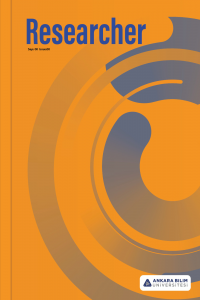Sayısal Elektromanyetikte Geniş Bant Frekans Analizi Uygulama Sonuçlarının İlişkisi ve Ardışıklığı: Kaydırılmış Frekans İç Eşdeğerliği
Yeni çözüm yöntemlerine ulaşmak için saçılma problemleri araştırmacılar tarafından değerlendirilmiştir. Bu bildiride, homojen ve homojen olmayan 2B ve 3B yapılar için çok frekanslı bantta saçılma hesaplama analizi Kaydırılmış Frekans İç Eşdeğerliği (SFIE) ile sunulmaktadır. Bu makale aynı zamanda, daha fazla araştırma alanı için konu hakkında araştırmacıları aydınlatmak için SFIE üzerindeki sonuçların karşılıklı ilişkisini tek bir yerde önceki çalışmaların bir koleksiyonudur.
Bu teori, bölge içindeki ω frekansındaki elektromanyetik alanın, farklı frekans ω0'da yayılan bir dizi eşdeğer akım kullanılarak çözülebileceğini göstermiştir. Seçilen bu ω0 frekansı, olay alanı frekansı değişirken değişmez. Literatürdeki analiz yöntemi, sayısal analizin ilgili frekans sayısı kadar tekrar edilmesini gerektirmektedir. Her tekrar, bilgisayar zamanına eklenir.
Elektrik ve Manyetik Alan İntegral Denklemlerini (EFIE ve MFIE) çözen SFIE algoritması, yapının dielektrik-manyetik özelliklerini kapsayan akım eşdeğerliğini tanımlar. SFIE uygulamalarının 2B ve 3B keyfi geometriler için başarılı sonuçlar verdiği kanıtlanmıştır. SFIE, kayıplı nesneler için de oldukça başarılı sonuçlar sağlar.
Anahtar Kelimeler:
Electromagnetik, Sayısal Analiz, , Sonlu Elemanlar Yöntemi, Saçılma Analizi
Interrelation and Succession of Application Results of the Wide Band Frequency Analysis in Numerical Electromagnetics: Shifted Frequency Internal Equivalence
Scattering problems have been evaluated and studied to reach to new solution methods by researchers. In this paper, the scattering calculation analysis in multi-frequency band is presented for the homogenous and the inhomogeneous 2D and 3D structures by the Shifted Frequency Internal Equivalence (SFIE). This paper is also a collection of the previous studies in one place, the interrelation of results on SFIE to enlighten the researchers on the subject matter for further research areas. This theory has shown that the electromagnetic field at frequency ω inside the region can be solved by using a set of equivalent currents radiating at the different frequency ω0. This chosen ω0 frequency is not changed while the incident field frequency changes. The analysis method in the literature requires repetition of the numerical analysis as many times as the number of the related frequency. Each repetition adds up to the computer time. SFIE algorithm which solves Electric and Magnetic Field Integral Equations (EFIE and MFIE) defines current equivalency covering the dielectric-magnetic features of the structure. SFIE applications are proved to give successful results for 2D and 3D arbitrary geometries. SFIE also provides very successful results for lossy objects.
___
- [1] A. Köksal, “Shifted-Frequency Internal Equivalence”, IEEE Trans. Microw. Theory Tech., Vol. 46, No. 1, pp. 76-81, Jan. 1988.
- [2] A. Köksal, “Multifrequency Formulation for Electromagnetic Scattering Using Shifted-Frequency Internal Equivalence”, IEEE Trans. Microw. Theory Tech., Vol. 47, No. 2, pp. 150-155, Feb. 1999.
- [3] A. Ünal, S. Özdemir, A. Köksal, “A Direct Proof of SFIE”, IEEE Trans. on Antennas and Propagation, Vol. 66, No. 4, pp. 2141-2142, Apr. 2018.
- [4] E. Karapinar, "Shifted frequency internal equivalence 2D application", 2009 International Conference on Electrical and Electronics Engineering - ELECO 2009, Bursa, 2009, pp. II-280-II-283.
- [5] S. Özdemir, A. Ünal, A. Köksal, “Application of Shifted Frequency Internal Equivalence to Multi-frequency Scattering Problems”, IEEE Trans. on Antennas and Propagation, Vol. 65, 9, Sept. 2017.
- [6] A. Ünal, E. Karapinar, and A. Köksal. "Accuracy and bandwidth investigation of shifted frequency internal equivalence in 2D." 2014 IEEE Antennas and Propagation Society International Symposium (APSURSI). IEEE, 2014.
- [7] B. Aydemir, A. Köksal, “Application of the Shifted Frequency Internal Equivalence to Two Dimensional Lossy Objects”, Advanced Electromagnetics, VOL. 8, NO. 2, September 2019.
- [8] R. F. Harrington, “Field Computation by Moment Methods”, Macmillan, New York, US, 1968.
- [9] J. Jin, “The Finite Element Method in Electromagnetics”, John Wiley & Sons, New York, US, 2014.
- [10] L. Zheng-liang, G. Shu-xi, M. Ji and W. Xing, “Impedance matrix interpolation based on method of moments for solving radiation problem over a frequency band”, Int. Con. On Micr. And Millimeter Wave Tech., 3, 1, 1-3, 2012.
- [11] V. V. S. Prakash and R. Mittra, “Characteristic basis function method: A new technique for efficient solution of method of moments matrix equations”, Microw. And Opt. Tech., 36,2,95-100,2003.
- [12] Nagaraja, K.V., Rathod, H.T., Symmetric Gauss Legendre Quadrature Rules for Numerical Integration over an Arbitrary Linear Tetrahedra in Euclidean Three-Dimensional Space, Int. Journal of Math. Analysis, 4, 19, 921–928, 2010.
- [13] D.A. Dunavant, 1985, “High Degree Efficient Symetrical Gaussian Quadrature Rules for The Triangle", Int.Journal For Numerical Methods In Eng. Vol.21, 1129-1148.
- [14] S. Özdemir, “Application of Shifted Frequency Internal Equivalence to 3D Electromagnetic Scattering Problems”, Phd Dissertion, Hacettepe University, 2016.
- [15] D. R. Wilton, S. M. Rao, A. W. Glisson, “Potential integrals for uniform and linear source distributions on polygonal and polyhedral domains”, IEEE Transactions on Antennas and Propagation Theory, AP-32, 3, 276–281, 1984.
- [16] A. Köksal, “Multifrequency Formulation for Electromagnetic Scattering Using Shifted -Frequency Internal Equivalence”, IEEE Trans. M.T.T., vol.47, pp. 150-155, 1999.
- ISSN: 2717-9494
- Yayın Aralığı: Yılda 2 Sayı
- Başlangıç: 2013
- Yayıncı: Ankara Bilim Üniversitesi
Sayıdaki Diğer Makaleler
Impact of Covid-19 on Employees Transportation in Morocco : Optimization using OCVRPTW
Anas LAASSIRI, Abdelfettah SEDQUI
Investıgatıon Of Factors Affectıng Lıfe Satısfactıon Of Indıvıduals Wıth Ordınal Regressıon Analysıs
Alper Cüneyt TÜRKMEN, Hülya ŞEN
Ercüment KARAPINAR, Sevda ÖZDEMİR
Deniz Kazaları Risk Olasılığının Makine Öğrenmesi İle Tahmin Edilmesi
Bılal KARROUMI, Abdelfettah SEDQUI
İç Nokta Optimizasyon Yöntemiyle Optimum Güç Akışı
Yunus YALMAN, Özgür ÇELİK, Adnan TAN, Kamil Çağatay BAYINDIR
AFET YÖNETİMİ ARAŞTIRMALARINDA OYUN TEORİSİ UYGULAMALARI
